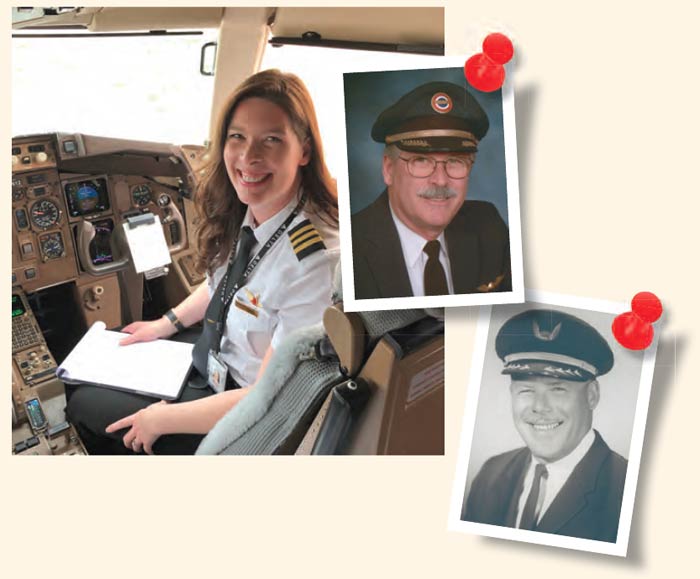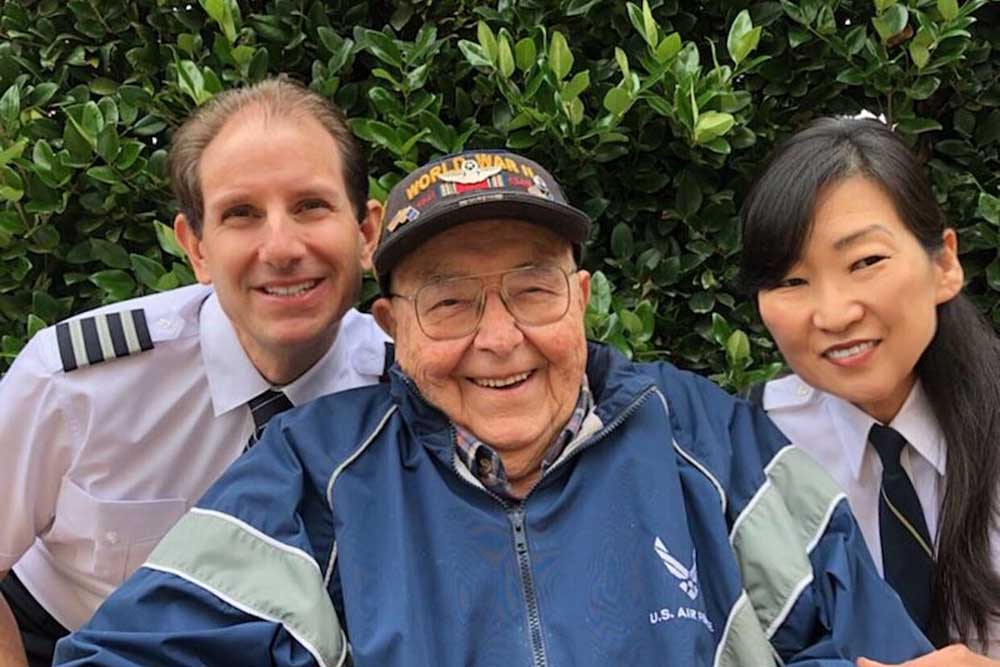All in the Family
‘Do It Again, Dad, Do It Again’
By F/O Nicole Poague (Delta)

F/O Nicole Poague (Delta) sits in the cockpit in Shang-hai, China. Poague’s father, left, and grandfather, below, were both ALPA members.
I began flying with my dad in light aircraft when I was still small enough that my feet couldn’t reach the pedals. My dad would fly a maneuver that he called a “whipper dill roll,” and when we leveled off I’d say, “Do it again, Dad, do it again.” That’s when my parents knew I’d be the family’s next pilot.
My family’s aviation story began with my grandfather, Lane W. Smith, in 1935. He flew a Waco biplane as an aerial chauffer before becoming an airline pilot for Western Air Express, starting out flying the B-247. My grandmother, Edythe Anderson, was hired as a stewardess for the airline in 1937. Western’s main base was in Burbank, Calif., and the airline flew the BUR–LAS–SLC route and back—and along the way my grandparents met.
My grandfather was commissioned as a second lieutenant in the Army Air Corps when World War II started and was assigned to the ferrying division of the air transport command. He ended the war as a colonel in the Eighth Air Force and earned the Air Medal, Distinguished Flying Cross, and the Legion of Merit for his writings in the Flying Safety Journal. Postwar he served as chief pilot and retired from Western Airlines on the B-707 (720B) after a 35-year career.
My father, Kagel Smith, started his aviation career at eight years old flying on the jumpseat of his dad’s Western DC-4. Like me, he knew following in his father’s footsteps was exactly where he wanted to be. In 1968, West Coast, Pacific, and Bonanza merged; my dad was in Class No. 1 of the new airline Air West, soon to be Hughes Air West, Republic, and then Northwest Airlines. After his 34-year career flying the Fairchild F-27, DC-9, MD-80, and B-727, my dad retired in 2002.
By then I was on my way. I continued flying with my dad through high school, soloing our Piper Tomahawk on my 16th birthday and working my way up to the Beech-18 (C-45). One day I was following him in the Tomahawk but couldn’t keep up with the Beech-18. Pushing full power, I thought I lost him. Then I looked off my right shoulder and there he was with the gear down and flaps out in slow flight, waving hello with a grin from ear to ear. That’s when I knew I wanted to be just like my dad; he always had a way of making things happen.
I attended Embry–Riddle Aeronautical University, where the flying was career-like compared to life at home. Then my internship with Northwest Airlines started, and I was lucky enough to sit on my dad’s MD-80 jumpseat all semester.
One memorable jumpseat with my dad started on a dark and stormy night, flying MSP–GTF dodging thunderstorms and turbulence so strong it kicked off the autopilot. I tightened my seatbelt, feeling nervous and sweating, thinking, “Is this what airline pilots do? I’m scared that I can’t do this for a living.” Then I watched my dad hand fly an NDB approach and grease it like nothing phased him. That’s when I knew I was going to be the next airline pilot in the family.
After college, I flight instructed student pilots and couldn’t wait to get employed by an airline. I was hired by Scenic Airlines and flew air tours in a Twin Otter from Las Vegas, Nev., to the Grand Canyon, Monument Valley, and Bryce Canyon. After six months I upgraded to captain. Then I was off to SkyWest Airlines for nearly a decade.
In 2014 I was a new hire at Delta Air Lines. It was surely meant to be, since Western and Northwest Airlines, the homes of my grandfather and dad, had merged into Delta. I’m proud to say I’ve flown the mighty Mad Dog, just like my dad; the B-737; and now the B-757/767. And I wouldn’t change a thing about my journey. We’re three generations of airline pilots and three generations of ALPA. I love every minute of today and look forward to tomorrow.
World War II Veteran, Test Pilot, Airline Pilot, and Mentor
By F/O Robert Knebel (FedEx Express)

F/O Robert Knebel (FedEx Express), left, with his wife, F/O Kelly Knebel (Alaska), and Uncle John.
My interest in flying isn’t hard to trace. I grew up listening to my Uncle John’s stories about a career that spanned aviation’s golden years and many of its greatest characters and aircraft. John is now 97 years old and is still going strong! He started flying in World War II as an Army Air Corps Air Transport Command ferry pilot flying everything from fighters like the P-51 to bombers like the B-24. At one time, he was checked out in 17 different aircraft. He was one of the first pilots to fly the Lockheed P-80—America’s first jet fighter. After the war, he flew dignitaries including Charles De Gaulle, a man he was not fond of, and Jimmy Doolittle, a friend and man he greatly respected.
After retiring from the Air Force as a lieutenant colonel, he was hired by Convair as a test pilot. He flight-tested the infamous XFY-1 Pogo, an experience he felt lucky to survive! He was also a test pilot on the F-102, B-36, and B-58. He set the transcontinental speed record for seaplanes in 1955 in a CV-R3Y Tradewind, an eight-engine flying boat. Later in his career at Convair, he switched to the airliner division. He was a test pilot on the CV-240, -340, -440, -880, and -990.
One day he was called into the office on short notice. Howard Hughes was there and wanted to take the -880 on a flight. After departing San Diego, Calif., and flying eastbound for a bit, Hughes asked to take the controls. He surprised John and the flight engineer by chopping the throttles and winging the aircraft over, almost into a split S. He told them he was landing in Palm Springs, Calif. After touching down, a car met the aircraft. Hughes thanked them for the flight, leaving them behind.
John left Convair in 1965 as a chief engineering test pilot to fly for the airlines. He worked for several small carriers before starting in 1966 at Trans International Airlines, whose pilots joined ALPA in 1977.Stories of his time there were a major inspiration for my decision to become an airline pilot. He recounted flying to far-flung places all over the world, often on short notice, for the charter airline. He flew cargo to Japan for the U.S. military and a few days later tourists to Paris, France. He told me about the infamous approach into Hong Kong’s Kai Tak Airport with the sharp turn at the checkerboard on the mountain.
Although being color-blind didn’t stop John from flying, my nearsightedness ruled out military flying for me. I started flying at age 16 and worked my way up in civilian aviation. I met my wife, Kelly, now a pilot for Alaska Airlines, when I was a flight instructor.
I got my big break in 2005 when I was hired by World Airways. World, a competitor of Trans International Airlines in John’s time, allowed me to do the same type of flying John finished his storied career doing. I, too, flew both passengers and cargo, and I felt honored to bring our brave men and women home from combat. Trans International Airlines went out of business in the 1980s, and World ceased operations in 2014. I was very fortunate to be hired by FedEx Express and am now flying the MD-11 worldwide again.
John was disappointed when he had to retire at age 60. I can’t imagine a time when I’ll no longer be able to sit behind the controls of an airliner.
Does the love of flying run in your family?
Many ALPA members have inspiring stories to share about the generations of airline pilots that run in their immediate family. Learn more and share your story.

